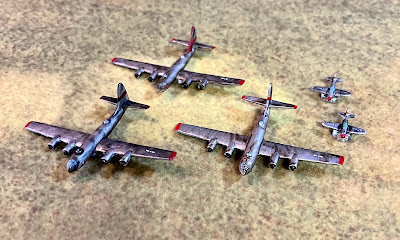Dateline: November 21th, 1950
Location: MIG Alley
By August of 1950, UN forces had taken Pyongyang and the North Korean air force had been silenced. However, the war continued as UN forces closed in on the Yalu river border with China. B-29 bombers were hitting targets across North Korea. However, the entire war changed when Chinese forces attacked the UN in October throwing back the Eight Army However, the 1st Marine Division engaged near the Chosin Reservoir and reached the Yalu on Nov. 21st.
Far East Air Force (FEAF) aircraft supported these counter-attacks and defensive actions. B-29s and assorted fighter-bombers continued to attack targets of strategic and tactical value. It was in November that a flight of F-51 Mustangs first encountered the Mig-15 by the Yalu River. However, soon the Communists were contesting air superiority across the North with this new threat.
With that said, we will be playing an engagement between Mig-15s and USAF aircraft. We rolled up a Sortie and got a Bomber Interception mission. The Mig-15s main role was to stop the bombers from getting through!
Forces
USAF
3 B-29 Super Fortress
- Experienced Pilots
2 F-80 Shooting Stars
- Experienced Pilots
Soviets
3 Mig-15s
- Experienced Pilots
Mission:
Today's Sortie is a Bomber Intercept mission. Each Bomber that escapes off the table counts as a Kill for the Attacker.
Set-up:
1 MU will equal 1 inch and the board will be 48 by 48MU.
There is no difficult terrain on the board and the weather is clear.
In this case, the USAF is the Attacker. The Russians are the defenders.
Weather, sortie type, and Attacker were all determined using the methods found in the main
White Star/Red Star rulebook.
If an aircraft is off the base, it is at Low altitude, on the base is combat altitude, and on a dice is High altitude. I won't be following the details on a turn by turn basis. Instead, I will break it down into three broad phrases; Maneuver Phase, Battle Phase, and Endgame and try to cover the battle in broad strokes rather than turn-by-turn, aircraft by aircraft detail.
Maneuver Phase:
No planes are deployed until they are detected. However, they are all detected all at once. The 4th turn the USAF and the Russians are detected. The B-29s are set-up across the board at maximum forward movement at high altitude. The Shooting Stars are at High and Combat between B-29 1 and 2. The Mig-15s stack up coming in on B-29 2 in the center, at all three altitudes.
In the initial pass, the Mig manages to down the 2nd B-29! The Shooting Stars close in and engage, but the Migs dodge away from the incoming fire. Everyone still has ammo. After the Experienced and Ace phases, the Migs seem out of position, but have 1 kill.
Battle Phase:
The Migs try to turn back onto the attack, but a Shooting Star lines up and fires a deflection shot at long range, but runs out of ammo. The shots fail to strike home! This causes him to break away and head for home at high altitude.
Due to poor flying, a Mig breaks off his attack and heads for home. That leaves his wing leader, and a squadron mate. The B-29s are almost to their target areas.
Disengagement Phase:
The USAF makes a mistake and moves the disengaging F-80 first. This gives a Mig time to swoop in on a B-29 and blast it apart. However, the last B-29 and Shooting Star disengage off the board. This is soon followed by the last remaining aircraft disengaging by the end of the turn.
Conclusion:
A very narrow Soviet victory. The USAF got 1 Kill for a B-29 escaping, while the Soviets downed 2 bombers for 2 Kills.
The introduction of the Mig-15 changed the complexion of the war. The USAF had air superiority over the majority of Korea, but the Mig-15 kept the areas close to the Chinese border as contested air space. Eventually, the USAF suspended day time attacks with B-29s, and switched them over to night time bombing.
Good, quick fun. The key to this game is deployment after detection and activation order. We saw that today. We have now played through two major engagement types for the early part of the war. It is now time to move onto 1951, where much of the early air battles involved attacking and defending ground attacks from fighter-bombers.
Until next time!
Become a Patron and get access to all the cool stuff, a peak behind the curtain of Blood and Spectacles, and early-access to playtest games!
Check out the latest publications and contact me at our
Blood and Spectacles Website










No comments:
Post a Comment